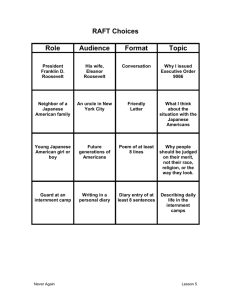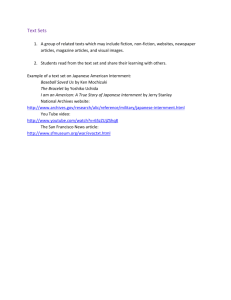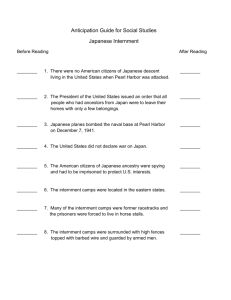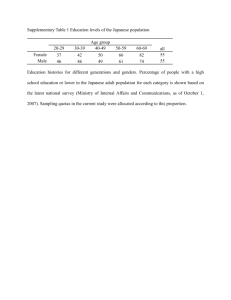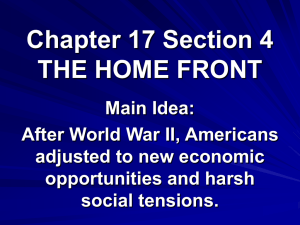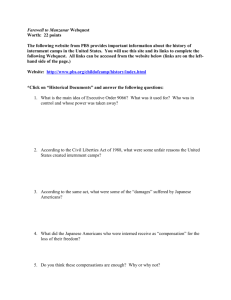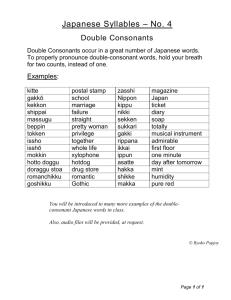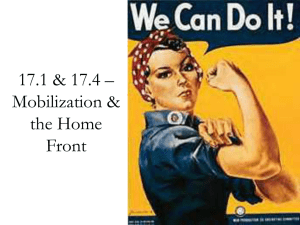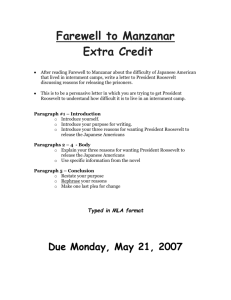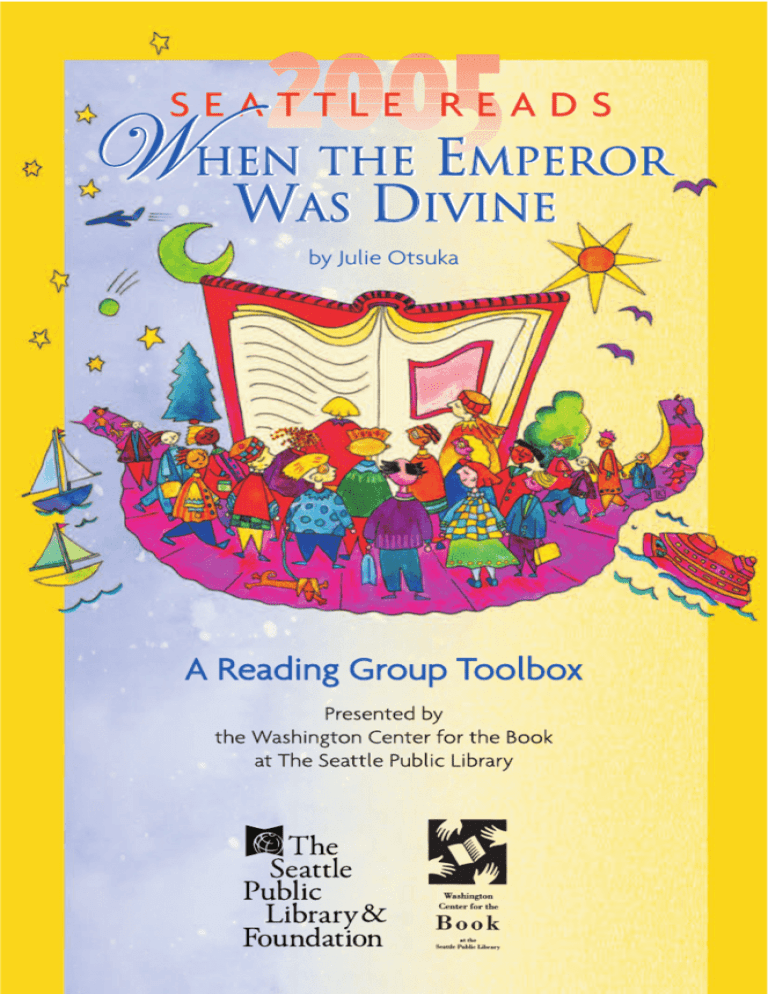
SEATTLE READS
� HEN THE EMPEROR
HEN THE MPEROR
WAS DIVINE
by Julie Otsuka
A Reading Group Toolbox
Presented by
the Washington Center for the Book
at The Seattle Public Library
S E AT T L E R E A D S
W HEN THE EMPEROR
WAS DIVINE
by Julie Otsuka
Anchor Books, 2003
A Reading Group Toolbox
Presented by
the Washington Center for the Book
at The Seattle Public Library
S E AT T L E R E A D S
The Washington Center for the Book at The Seattle Public
Library invites everyone to take part in “Seattle Reads,” formerly
“If All of Seattle Read the Same Book,” a project designed to
broaden and deepen an appreciation of literature through reading
and discussion.
Each year the Washington Center for the Book hosts an
author for a series of free programs. Prior to the visit, the Center
develops background material and study guides (called “reading
group toolboxes”) and encourages book groups and individuals
throughout the region to read and discuss the featured book.
Featured Works
2004: Seattle Reads Isabel Allende
My Invented Country (HarperCollins, 2003)
City of the Beasts (HarperCollins, 2002)
Paula (HarperCollins, 1995)
The Infinite Plan (HarperCollins, 1993)
The Stories of Eva Luna (Atheneum, 1991)
Eva Luna (Knopf, 1988)
The House of the Spirits (Knopf, 1985)
Note: The 2004 series featured seven titles from
Allende’s body of work
2003: A Gesture Life by Chang-rae Lee (Riverhead Books, 1999)
2002: Wild Life by Molly Gloss (Mariner Books, 2001)
2001: Fooling with Words: A Celebration of Poets and Their Craft
by Bill Moyers (Morrow, 1999)
1999: A Lesson Before Dying by Ernest Gaines
(Vintage Books, 1994)
1998: The Sweet Hereafter by Russell Banks (HarperCollins, 1991)
TOOLBOX CONTENTS
About the Author
4
Summary
5
A Conversation with Julie Otsuka
6
When the Emperor Was Divine
10
Book Club How-To’s
12
Recommended Reading
17
© Jerry Bauer.
ABOUT THE AUTHOR
Julie Otsuka was born and raised in
California and lives in New York. She attended
Yale University, where she graduated magna
cum laude with a bachelor’s degree in art. After
pursuing a career as a painter for several years, she
turned to writing at age 30.
Otsuka earned an M.F.A. from Columbia
University. One of her stories was anthologized in
Scribner’s Best of Fiction Workshops, 1998.
When the Emperor Was Divine earned the
2003 Asian American Literary Award. It was
longlisted for the Orange Prize in England and
was a finalist for the Barnes & Noble “Discover
Great New Writers” Award.
Otsuka’s family’s experience is similar to that of other Japanese Americans on
the West Coast during World War II. Her grandfather was arrested by the FBI the day
after Pearl Harbor was bombed, and her mother, uncle, and grandmother were sent to
an internment camp several months later. But aside from the basic facts of the arrest
and being sent to a camp, the book is a work of fiction and, according to Otsuka, the
characters don’t resemble anyone in her own family.
4
SUMMARY
An unnamed Japanese American family is sent to an internment camp during
World War II. Their emotional devastation is revealed in spare, haunting prose that
draws the reader into the story.
When the Emperor Was Divine opens with the mother returning a book to the
library when she notices the sign posted all around Berkeley, where the family lives.
She calmly readies herself and her two children for a journey that, it turns out, she
has been expecting since her husband was arrested and taken away after the Pearl
Harbor attack.
The family travels by train to the Utah desert, and gradually the reader
learns that everyone on board is Japanese American. The woman and her children
will spend more than three years living in tarpaper barracks behind barbed wire,
imprisoned “for their own safety,” until the war is over.
Shifting narrative points of view with each chapter, from the mother to the 11year-old girl, to the 8-year-old boy, Otsuka portrays the devastation, dehumanization,
and hardships of the camp experience. The fourth chapter looks back on the family’s
return to their ransacked home, to a neighborhood that doesn’t want them, where the
children are either ignored or harassed. In a heartbreaking reunion, the father finally
returns home.
The final chapter, titled “Confession,” stands in sharp contrast to the rest of
the novel. It is only here that anger surfaces in the father’s diatribe against those who
imprisoned him.
5
A CONVERSATION WITH JULIE OTSUKA
Interview with Julie Otsuka, Author of When the Emperor Was Divine
December 3, 2003
Julie Otsuka’s debut novel When the Emperor Was Divine tells the story of a Japanese
American family forced to live in an internment camp during World War II. In
five concise chapters, Otsuka presents the points of view of each family member,
creating an intimate and detailed portrait of people living through one of America’s
darkest and most shameful periods: the internment of more than 110,000 Japanese
Americans for 3 1/2 years.
Though her story centers around this tragic time in American history, Otsuka’s
unsentimental style strips characters to their core to create a powerful story of exile
and racism that is particularly resonant today. She explains, “I wanted to write a novel
about real people ... their experience is universal not only for Japanese Americans,
but for people of any ethnic group. All throughout history people have been rounded
up and sent away into exile. The predicament of the family in my novel – ordinary
people caught up in extraordinary circumstances beyond their control – is a very
human one.”
Julie Otsuka was born and raised in California. She is a graduate of Yale
University and received her M.F.A. from Columbia. She lives in New York City.
Otsuka is one of the winners of the Sixth Annual Asian American Literary Awards and
was honored at the Asia Society on December 8, 2003.
AsiaSource spoke with Otsuka about the writing of her novel, her own family’s
internment, and the relevance of this experience for today’s world.
Your family was interned during the war. Can you tell me how this influenced
the writing of When the Emperor Was Divine?
There was always a lot of silence in my family about the internment – nobody seemed
to want to talk about it. The war was something that I, too, tended to avoid in my
own work. For years I wrote only comic stories, but as time went on, images of the
war began to surface in my writing. So clearly the camps were something I needed to
write about. The first chapter of my novel, “Evacuation Order No. 19,” was the first
piece of ‘serious’ fiction I’d ever written.
Since 9/11, new regulations for immigrants from Muslim nations as well as
other countries have often been compared with the Japanese internment. I
just saw a documentary called Lest We Forget that draws very direct parallels
6
between the two American experiences. Do you think that Americans have
learned from the injustice of the Japanese internment? Or do you think it could
happen again?
I don’t think we’ve learned much from the past at all; it’s as if it never even happened.
Even today, when I speak to young people – high school and college-age students
– it is striking that some of them know nothing about the internment of the
Japanese Americans at all. It’s still not taught in most history classes, or it’s given
a brief mention, at most. And I do think it could happen again – I never thought
this until Sept. 11. But everything that’s happening now – the targeting of Muslims
and Arabs in the U.S. for investigation and interrogation, the government’s ability to
label anyone an ‘enemy combatant’ and deprive him of his civil rights–is extremely
worrisome.
In this same documentary, there is an interview with the famous Japanese
American activist Yuri Kochiyama who talks about her own family’s internment.
It reminded me so much of your book. You really capture a universal experience
for many Japanese Americans. Is this why none of your characters have names?
Yes, but because their experience is universal not only for Japanese Americans, but for
people of any ethnic group. All throughout history people have been rounded up and
sent away into exile. The predicament of the family in my novel – ordinary people
caught up in extraordinary circumstances beyond their control – is a very human one.
You pay great attention to detail in your writing, which really makes the reader
feel a part of the experience. I know a lot of people have noticed this about your
novel and found it to be more powerful than focusing on the broader injustice
and victimization of the internment. Did you decide this early on or is this more
a result of your style of writing?
I never made a conscious decision to focus on detail. I think that, because of my
background as a painter, I’m very concerned with what the world looks like. I have
to visualize a scene in my head before I can begin to write it. Also, I wasn’t interested
in writing a novel about injustice and victimization, I wanted to write a novel about
real people.
When I read the introduction of the mother character I felt like you could be
describing any other American woman of that time in the sense that her being
Japanese seemed incidental, and this made the subsequent internment of her
7
and her family more powerful for me. Perhaps because I am Asian American
this resonated more for me. How much do you identify with being of Japanese
heritage?
Very little. Although my father is from Japan, my parents only spoke English at home,
and we were taught nothing about Japanese culture. It was only later, when I went to
college and began to study Japanese, that I became more interested in my heritage.
Have you been to Japan? If so, what was your experience like?
I went to Japan the summer I was 19 and visited my father’s relatives in the town
where he grew up. My father is from a small town in the countryside in the
mountains. The experience was wonderful, but very disorienting. I don’t think I’d
ever been any place that made me feel so ‘other’ before. Japan and the Japanese were
much more foreign than I’d ever imagined. I realized what a long way my father was
from ‘home,’ whatever that is.
I also think the numbness of the mother as she packs up the family to leave is
very striking. She is very task-driven and when she kills the dog it reinforces
this state of mind. Do you sense from your own family’s experience that this is
something that Japanese Americans would rather forget as a bad memory or do
you find that this injustice has created a more politicized Japanese American
community?
As for my mother and her family, the internment is definitely something they would
rather forget because of the shame and the stigma they felt at having been labeled
‘disloyal.’ I think the desire to forget was quite common among the people who came
out of the camps. They wanted to put the past behind them and just get on with their
lives. But I do think that, because of what happened, the following generations of
Japanese Americans have definitely become more politicized.
Your last chapter is very different from the rest of the novel. Some people might
feel it is too abrupt but I found it to be a very powerful ending. Through the
whole story the family is dealing with the day-to-day and don’t express much
anger. But the last chapter feels like a culmination of all the anger that they, as
well as Japanese Americans collectively, must have felt. How and why did you
decide to write the conclusion this way?
I actually had no idea how I’d end the book. But one day, while I was working on the
8
second-to-last chapter, I ‘heard’ the angry voice of the father. The words came to me
very quickly – I scribbled them down and I knew, immediately, that they were the
‘right’ ending for the book. I was surprised that I had such easy access to the father’s
anger – I almost felt like I was channeling a voice from beyond. That ending simply
came to me – it was a gift.
You mentioned that you were also a painter before you started writing.
It sounds like writing became a better fit for you than painting. How did you
discover this?
I stopped painting because I became extremely self-critical and overwhelmed
by doubt and couldn’t go on. After I stopped painting, I began going to my
neighborhood café and reading every day – I didn’t know what else to do with
myself, and I found stories terribly consoling. Reading was the only thing that seemed
to make me feel better. After reading for a couple of years, I began to think about
writing, and signed up for a workshop. I felt I had nothing to lose, since I’d already
failed as a painter, so I wasn’t afraid. And in fact, I found that I felt very comfortable
with language. It seemed a much easier medium to work with than painting. And I
still feel that way.
Who are some of your favorite writers? Are their any Asian or Asian American
writers you find inspiring?
Some of my favorites are: Ernest Hemingway, Jamaica Kincaid, Marguerite Duras, Joy
Williams, Lydia Davis, Colum McCann, Annie Ernaux, Joan Didion, James Salter,
Alice Munro, Richard Ford, Rick Bass. I’m also a big Murakami fan. I love Gish Jen’s
humor and pathos. I admire Kawabata’s Palm of the Hand Stories. And Ishiguro, too.
One of my favorite Asian American writers is le thi diem thuy—I just read her book,
The Gangster We Are All Looking For
For, and it’s stunning.
Are you working on a new book now?
Yes, I’ve started writing the next one, but feel superstitious about talking about it this
early on. Don’t want to jinx it. Silly, I know.
Interview conducted by Cindy Yoon of AsiaSource, www.asiasource.org. Copyright © 2003. Asia Society.
All rights reserved. Reprinted, with permission.
9
WHEN THE EMPEROR WAS DIVINE
1.
While many Americans may have some knowledge of the internment of Japanese
Americans during World War II, Otsuka lends a unique perspective to the
events. What insights did you glean from reading this book, and how did it
change your thinking about this historical period and about those who were
interned?
2.
How does the author use images and dreams to bring out larger themes in the
book? For instance, the pictures of Jesus and the little Princess Elizabeth the
woman carefully removes from the walls of her home and places “together facedown in a box. She made sure to put Jesus on top” (page 8). The girl, age 10,
liked “boys and black licorice” (page 13). The soldier on the train who called
out “Shades down” (page 43). The images of water on page 58 and in the boy’s
dream on page 59. The woman’s rosebush, seen at both the beginning of the
story and in the final scene of the book (page 139).
3.
Why did the author choose to relate the story in mostly short, episodic scenes,
dreams, conversations, and brief images? Why the unsentimental, aloof tone?
What effect does this style have on the reader?
4.
Why do the woman, the girl, the boy, and the father remain unnamed in the
story?
5.
What is the meaning of the title? How does the title relate to the book?
6.
The boy continually looks for his father, even in camp, knowing his father is
elsewhere. Why does the father’s absence play such a major role in this novel?
What replaces the father in this family?
7.
How does life in the internment camp change each of the characters? How did
the internment of Japanese Americans affect America?
8.
What did each member of the family do to weather their ordeal? What are the
characteristics of a survivor?
9.
What message is the author sending, when the father returns, beaten and
silent? Why doesn’t he tell his family about his own experiences, and why don’t
they ask?
10
10. Upon their release from the camps, Japanese Americans were faced with starting
their lives over, having difficulty finding homes and jobs, with few of their
possessions from prior to the war. What difficulties did this family face, and how
does their experience relate to that of other Japanese Americans during this time?
11. Who is confessing in the final chapter of this book, and to whom? How does the
“confession” at the end of the novel point out the fallacies inherent in a nation’s
decision to detain or imprison suspects on the basis of ethnicity, religion, or
nationality?
12. What were the real reasons for Evacuation Order No. 19? Was it really for the
“protection” of Japanese Americans, a matter of “national security” or “military
necessity” (page 70)? Who was responsible for the internment camps? Why
didn’t most people know about them?
11
RECOMMENDED READING
Fiction
Gretel Ehrlich, Heart Mountain
David Guterson, Snow Falling on Cedars
Jeanne Wakatsuki Houston, The Legend of Fire Horse Woman
Stewart David Ikeda, What the Scarecrow Said
Joy Kogawa, Obasan
John Okada, No-No Boy
Rahna Reiko Rizzuto, Why She Left Us
R.A. Sasaki, The Loom and Other Stories
Hisaye Yamamoto, Seventeen Syllables and Other Stories
Nonfiction
Roger Daniels, Prisoners Without Trial: Japanese Americans in World War II
Louis Fiset, Imprisoned Apart: The World War II Correspondence of an Issei Couple
Stan Flewelling, Shirakawa: Stories from a Pacific Northwest Japanese American
Community
Jeanne Wakatsuki Houston and James D. Houston, Farewell to Manzanar: A True Story
of Japanese American Experience During and After the World War II Internment
Tetsuden Kashima, Judgment Without Trial: Japanese American Imprisonment During
World War II
Lauren Kessler, Stubborn Twig: Three Generations in the Life of a Japanese American
Family
Greg Richardson, By Order of the President: FDR and the Internment of Japanese
Americans
Robert Sadamu Shimabukuro, Born in Seattle: The Campaign for Japanese American
Redress
David Takami, Divided Destiny: A History of Japanese Americans in Seattle
Yoshiko Uchida, Desert Exile: The Uprooting of a Japanese American Family
Michi Nishiura Weglyn, Years of Infamy: The Untold Story of America’s Concentration
Camps
Poetry
Lawson Fusao Inada, Legends from Camp
James Masao Mitsui, From a Three-Cornered World: New and Selected Poems
12
Anthology
Lawson Fusao Inada, Only What We Could Carry: The Japanese American Internment
Experience
Juvenile and Young Adult Fiction
Yoshiko Uchida, Journey to Topaz
Yoshiko Uchida, Journey Home
Virginia Euwer Wolff, Bat 6
Bound volumes and microfilm of internment camp newspapers in The Seattle
Public Library’s collection
Heart Mountain Sentinel, 1942-1945
The Minidoka Irrigator, 1942-1945
Pinedale Logger, 1942
13
READING GROUP TOOLBOXES
Reading group toolboxes are designed to enhance a book group’s discussion
of the author’s work. Toolboxes are available at all Seattle Public Library locations as
well as at many local bookstores. Toolboxes are also available on The Seattle Public
Library’s web site: www.spl.org.
BOOKS FOR BOOK GROUPS
The Washington Center for the Book lends hundreds of copies of the featured
book to book discussion groups during the two months prior to the author’s visit. To
request books for your book group, contact:
Washington Center for the Book
at The Seattle Public Library
bookgroups@spl.org
(206) 615-1747
For more information, contact:
Washington Center for the Book
at The Seattle Public Library
1000 Fourth Ave.
Seattle, WA 98104-1109
Chris Higashi, Associate Director
chris.higashi@spl.org
(206) 386-4650
Contributors to this toolbox include Jennifer Baker and Chris Higashi.
A generous grant from The Wallace Foundation supported the first three years of
“Seattle Reads.” Thanks to private gifts to The Seattle Public Library Foundation and a
major grant from the National Endowment for the Humanities, “Seattle Reads” is now an
annual program series of the Washington Center for the Book at The Seattle Public Library.
The 2005 series is part of “Reading Across the Map,” a multi-year project to foster
reading and discussion of works by authors of diverse cultures and ethnicities, made
possible by The Wallace Foundation.
Inaugural Year
Sponsor

